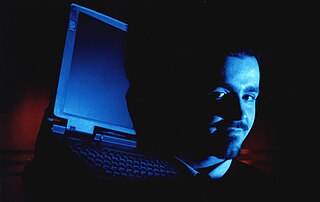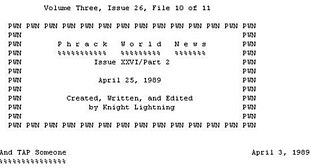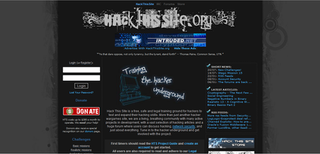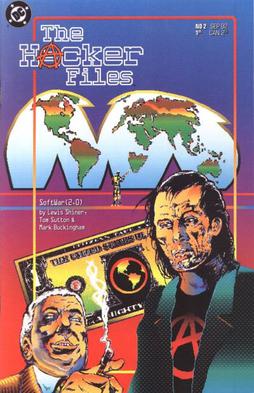Related Research Articles

A hacker is a person skilled in information technology who uses their technical knowledge to achieve a goal or overcome an obstacle, within a computerized system by non-standard means. Though the term hacker has become associated in popular culture with a security hacker – someone who utilizes their technical know-how of bugs or exploits to break into computer systems and access data which would otherwise be inaccessible to them – hacking can also be utilized by legitimate figures in legal situations. For example, law enforcement agencies sometimes use hacking techniques in order to collect evidence on criminals and other malicious actors. This could include using anonymity tools to mask their identities online, posing as criminals themselves. Likewise, covert world agencies can employ hacking techniques in the legal conduct of their work. On the other hand, hacking and cyber-attacks are used extra- and illegally by law enforcement and security agencies, and employed by state actors as a weapon of both legal and illegal warfare.

Phrack is an e-zine written by and for hackers, first published November 17, 1985. Described by Fyodor as "the best, and by far the longest running hacker zine," the magazine is open for contributions by anyone who desires to publish remarkable works or express original ideas on the topics of interest. It has a wide circulation which includes both hackers and computer security professionals.
Phreaking is a slang term coined to describe the activity of a culture of people who study, experiment with, or explore telecommunication systems, such as equipment and systems connected to public telephone networks. The term phreak is a sensational spelling of the word freak with the ph- from phone, and may also refer to the use of various audio frequencies to manipulate a phone system. Phreak, phreaker, or phone phreak are names used for and by individuals who participate in phreaking.
The Conscience of a Hacker is a small essay written January 8, 1986 by a computer security hacker who went by the handle of The Mentor, who belonged to the second generation of hacker group Legion of Doom.

Mathew Bevan is a British hacker from Cardiff, Wales. In 1996 he was arrested for hacking into secure U.S. Government networks under the handle Kuji. At the age of 21, he hacked into the files of the Griffiss Air Force Base Research Laboratory in New York.
Chris Goggans, is an American hacker, founding member of the Legion of Doom group, and a former editor of Phrack magazine. He is known as an expert in security, as well as for his statements on hacker ethic and responsibility.
A security hacker is someone who explores methods for breaching defenses and exploiting weaknesses in a computer system or network. Hackers may be motivated by a multitude of reasons, such as profit, protest, information gathering, challenge, recreation, or evaluation of a system weaknesses to assist in formulating defenses against potential hackers. The subculture that has evolved around hackers is often referred to as the "computer underground".

Craig Neidorf, a.k.a.Knight Lightning, was one of the two founding editors of Phrack Magazine, an online, text-based ezine that defined the hacker mentality of the mid 1980s.

Bruce Fancher is a former computer hacker and member of the Legion of Doom hacker group. He co-founded MindVox in 1991 with Patrick K. Kroupa.
Pwn is an Internet slang term meaning to "own" or to "outdo" someone or something.
Nahshon Even-Chaim, aka Phoenix, was the first major computer hacker to be convicted in Australia. He was one of the most highly skilled members of a computer hacking group called The Realm, based in Melbourne, Australia, from the late 1980s until his arrest by the Australian Federal Police in early 1990. His targets centered on defense and nuclear weapons research networks.
Electron was the computer handle of Richard Jones, a member of an underground hacker community called The Realm. Jones, born in June 1969, was one of three members of the group arrested in simultaneous raids by the Australian Federal Police in Melbourne, Australia, on 2 April 1990. All three — Nahshon Even-Chaim, Electron and Nom — were convicted of a range of computer crimes involving the intrusion into US defense and government computer systems and the theft of an online computer security newsletter in the late 1980s and early 1990.

HackThisSite.org, commonly referred to as HTS, is an online hacking and security website founded by Jeremy Hammond. The site is maintained by members of the community after his departure. It aims to provide users with a way to learn and practice basic and advanced "hacking" skills through a series of challenges in a safe and legal environment. The organization has a user base of over a million, though the number of active members is believed to be much lower. The most users online at the same time was 19,950 on February 5, 2018 at 2:46 a.m. CT.

The Hacker Files is a twelve issue DC Comics mini-series published from August 1992 to July 1993. It was written by Lewis Shiner and illustrated by Tom Sutton.
Michael Gregory Hoglund is an American author, researcher, and serial entrepreneur in the cyber security industry. He is the founder of several companies, including Cenzic, HBGary and Outlier Security. Hoglund contributed early research to the field of rootkits, software exploitation, buffer overflows, and online game hacking. His later work focused on computer forensics, physical memory forensics, malware detection, and attribution of hackers. He holds a patent on fault injection methods for software testing, and fuzzy hashing for computer forensics. Due to an email leak in 2011, Hoglund is well known to have worked for the U.S. Government and Intelligence Community in the development of rootkits and exploit material. It was also shown that he and his team at HBGary had performed a great deal of research on Chinese Government hackers commonly known as APT. For a time, his company HBGary was the target of a great deal of media coverage and controversy following the 2011 email leak. HBGary was later acquired by a large defense contractor.
Leonard Rose, aka Terminus, is an American hacker who in 1991 accepted a plea bargain that convicted him of two counts of wire fraud stemming from publishing an article in Phrack magazine.

In United States v. Riggs, the government of the United States prosecuted Robert Riggs and Craig Neidorf for obtaining unauthorized access to and subsequently disseminating a file held on BellSouth's computers. The file, referred to as the E911 file, gave information regarding BellSouth's products implementing 911 emergency telephone services. Riggs and Neidorf were both indicted in the District Court of the Northern District of Illinois on numerous charges relating to the dissemination of the E911 text file. As Riggs had previously been indicted in the Northern District of Georgia in relation to the same incident, his charges from Illinois were transferred to Georgia. Riggs ultimately pleaded guilty in Georgia and was sentenced to 21 months in prison and two years' supervised release. Neidorf pleaded not guilty in Illinois and the government dropped all charges against Neidorf four days after the trial began.
Plover-NET, often misspelled Plovernet, was a popular bulletin board system in the early 1980s. Hosted in New York state and originally owned and operated by a teenage hacker who called himself Quasi-Moto, whom was a member of the short lived yet famed Fargo 4A phreak group. The popular bulletin board system attracted a large group of hackers, telephone phreaks, engineers, computer programmers, and other technophiles, at one point reaching over 600 users until LDX, a long distance phone company, began blocking all calls to its number (516-935-2481).

The PEF Survey of Palestine was a series of surveys carried out by the Palestine Exploration Fund (PEF) between 1872 and 1877 for the Survey of Western Palestine and in 1880 for the Survey of Eastern Palestine. The survey was carried out after the success of the Ordnance Survey of Jerusalem by the newly-founded PEF, with support from the War Office. Twenty-six sheets were produced for "Western Palestine" and one sheet for "Eastern Palestine". It was the first fully scientific mapping of Palestine.
References
- ↑ "Beware: Hackers at play", Newsweek, September 5, 1983, pp. 42–46, 48